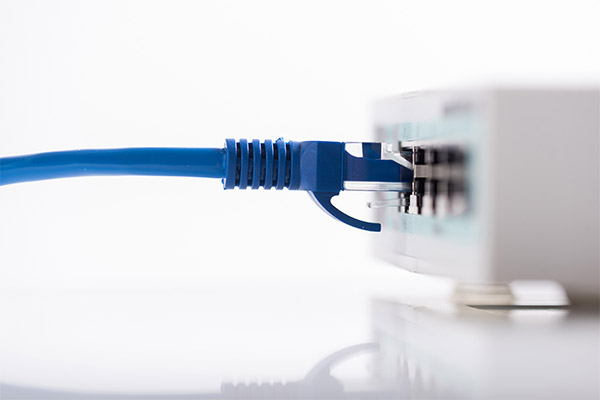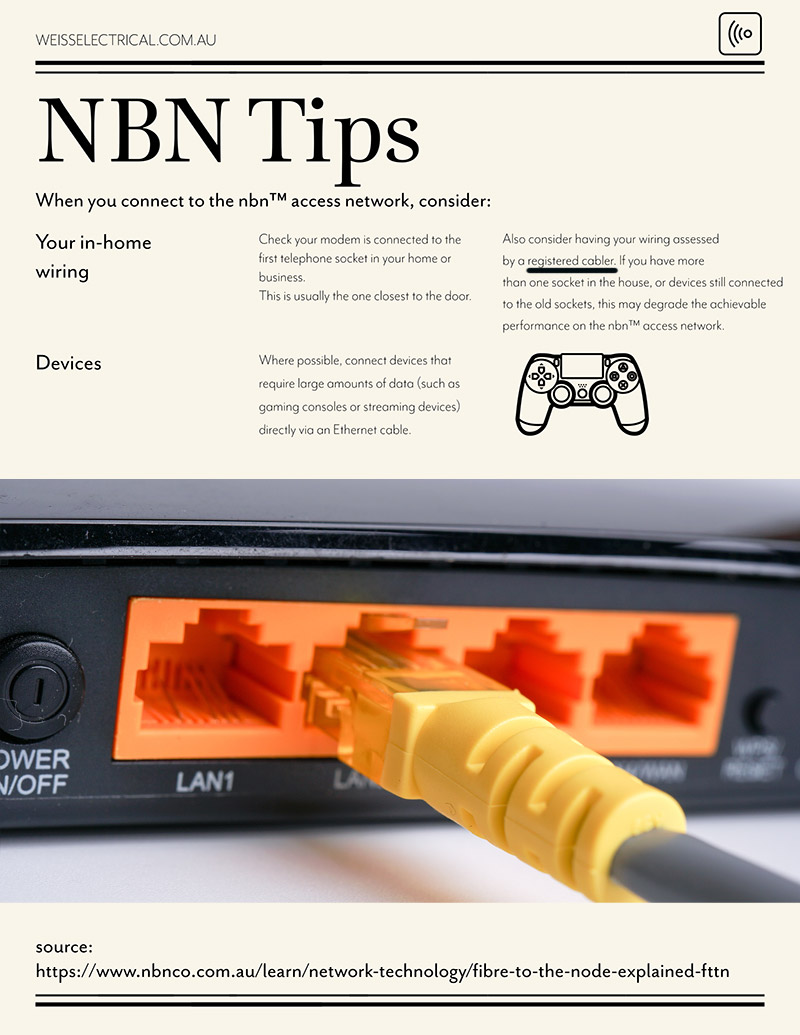
Hail up to 13 cm in Brisbane
- Dec 30 2025
- /
- 84

The National Broadband Network Company Limited (NBN™) is an Australian government-owned corporation tasked with designing, building and operating Australia's National Broadband Network as a 'monopoly wholesale broadband provider'.
The NBN Co. is responsible for building the infrastructure that connects Australians to the NBN. The NBN Co. delegates its work to major telecommunication infrastructure companies to manage the rollout of the network.
The rationale for this national telecommunications infrastructure project includes replacing the existing copper cable telephony network that is approaching 'end of life' with fibre optic cable (fibre).
Copper cable is adequate for a voice signal but has very limited bandwidth for internet use. Copper is also susceptible to oxidation which limits its life span. Fibre optic cable links provide over 1,000 times as much bandwidth as copper and can travel more than 100 times further. However, copper cable is much cheaper and quicker to install than fibre optic cable.
Fibre optic cables have a core that carries light to transmit data. This allows fibre optic cables to carry signals at speeds that are only about 31 percent slower than the speed of light—faster than Cat5 or Cat6 copper cables. There is also less signal degradation with fibre cables.
NBN installations will vary depending on the NBN access network technology that is currently available to a specific property.
Some safety-critical devices such as medical alarms, fire alarms and lift emergency phones may not be compatible with the NBN access network.
Internet service providers, known under NBN as retail service providers or RSPs, contract with NBN to access the network and sell fixed Internet access to end users.
Generally, the major telecommunication infrastructure companies contracted by the NBN Co. will NOT carry out cabling installations or modifications inside house or business building premises.

Weiss Electrical Brisbane is an Australian Registered Cabler and therefore licensed and authorised to conduct and install cabling inside your home and business premises in relation to ensuring a home or business is effectively connected to the NBN.
In-home cabling is strongly recommended as it can allow property owners to choose the location of the NBN connection box and may improve connectivity and data speeds within the premises. Only registered cablers can perform in-home cabling work to connect homes and business premises to the NBN broadband access network. Registered cablers, such as Weiss Electrical, are listed on the Australian Registered Cablers website.
http://www.registeredcablers.com.au/find-cablers/
The Multi-Technology Mix (MTM) used by NBN to connect a business or home to the NBN will vary depending on the existing technology or the cabling already being used in a street, suburb, location or region of Australia.
Prior to the NBN laying fibre optic cable, most of Australia's telecommunications cabling consisted of the slower copper cables used in the landline phone systems or coaxial cables connected to cable television services.
In some areas, NBN Co. is building fibre to the premises (FTTP) but in most locations it is only building fibre to the node (FTTN) or fibre to the curb (FTTC).
To save costs to NBN Co., these latter two network connections utilise some of Australia's ageing copper network or cable television lines for finishing home and business premise connections to the NBN fibre optic network.

NBN Fibre to the Node connections are where the existing copper network gets used to link the last part of an NBN connection below ground along the street and into home or business premises.
FTTN enables data services and broadband connections to run via a central network box, which is referred to as a node. The fibre node is likely to take the form of a street cabinet.
A modem router is required for connections that utilise Fibre to the Node.
Fibre to the Curb is faster than FTTN because it enables fibre optic cable to be closer to the home, compared to fibre to the node (FTTN) technology, which uses the existing copper network for a longer stretch underground before it gets to the home, causing slower speeds.
Fibre to the Premises is considered the best NBN connection type as it is more consistent in its delivery of high-speed internet because a fibre optic cable runs directly into homes or business premises - FTTP is also known as Fibre to the Home (FTTH).
FTTP means that no copper telephone lines are being used anywhere in the connection, making for significantly faster internet speeds, over 10 times faster than the best FTTC connections.
FTTP broadband is not only "super-fast" but has the potential for future expansion. It is also "super expensive" to install.
The average cost of an FTTP connection according to the NBN Co. is $4400. However, a woman in Melbourne reported paying $6,500 to have her home hard-wired with fibre optical cable to the NBN connection point about 80 metres away from her house.
She was surprised to be told by the installer that the five homes in between the connection point and her house would now be able to get FTTP connections to their homes at a much cheaper price, as she had paid for most of the necessary infrastructure. These houses would now only have to pay about $2,000 to connect to NBN fibre.
FTTP requires an NBN utility box to be installed outside your property boundary in an easy to access area and an NBN connection box installed inside your property.
Hybrid fibre-coaxial (HFC) is a telecommunications industry term for a broadband network that combines optical fibre to the boundary of a premise and coaxial cable into the home or building premise. It has been commonly employed by cable television operators since the early 1990s.
Fibre-to-the-premises (FTTP) and hybrid fibre coaxial (HFC) NBN services deliver about 86 per cent to 87 per cent of maximum plan speeds at busy hours, compared to about 79 per cent for fibre-to-the-node (FTTN) technology.
However, hybrid fibre-coaxial (HFC) is the worst NBN fixed-lined technology when it comes to outages according to a new report released by the Australian Competition and Consumer Commission (ACCC).
Fibre to the Curb (FTTC), Fibre to the Premises (FTTP), and Hybrid Fibre Coaxial (HFC) all have an NBN installed device that acts as the modem.
The Australian Communications and Media Authority recently announced that the NBN Authority to Alter rules will allow registered cabling technicians to make a range of changes to NBN equipment within an end-user's premises without seeking prior permission from NBN.
Such changes may include rewiring a home in order to move a Network Termination Device (NTD) from one room to another room that is more suited to the end user's needs.
The Authority to Alter previously only allowed registered cablers to modify internal cabling on the NBN FTTN Network.
The Authority to Alter has now been expanded to include modifying internal Copper, Fibre, Coaxial and Hybrid Fibre-Coaxial lead-in cables prior to the boundaries on NBN FTTP, FTTC and HFC Networks.
You may not know it...
As an Australian Registered Cabler, Weiss Electrical - Brisbane is qualified to carry out NBN Authority to Alter modifications inside the boundaries of homes, commercial and industrial properties.
Registered Cablers still need to adhere to the relevant cabling guidelines before starting work on or setting up premises to complete or modify a connection to the NBN access network.
However, modification of the NBN Wireless and Satellite premises networks still require permission from NBN. These networks are mostly used in remote areas of Australia.
In relation to the changed NBN Authority to Alter requirements, The Australian Cabler Registration Service reminded Registered Cablers to inform customers of the following important points:
1 Care must be taken when undertaking any work as the authorisation requires registered cablers to use only approved equipment and full testing.
2 At the completion of the work the registered cabler must provide the customer with a TCA-1 form or incorporate the details contained in the TCA-1 form in the invoice or job sheet they give to customers.
http://registeredcablers.com.au/tca-1/
Engaging registered cablers and qualified electricians who are licensed telecommunications technicians holds several advantages if you are planning to install or update data cabling systems, or complete or modify your NBN connections.
For instance, qualified electricians will use high-quality data cables and will consult you about the costs. Quality cables make a huge difference in optimising your business computers and devices.
Also, insurance policies and product warranties often specify that your policy will be void if you use an unregistered cabler.
Weiss Electrical Brisbane provides high quality, reliable electrical and data cabling services to residential, commercial and industrial customers.










Check out our amazing 9 STAR QUALITY GUARANTEE